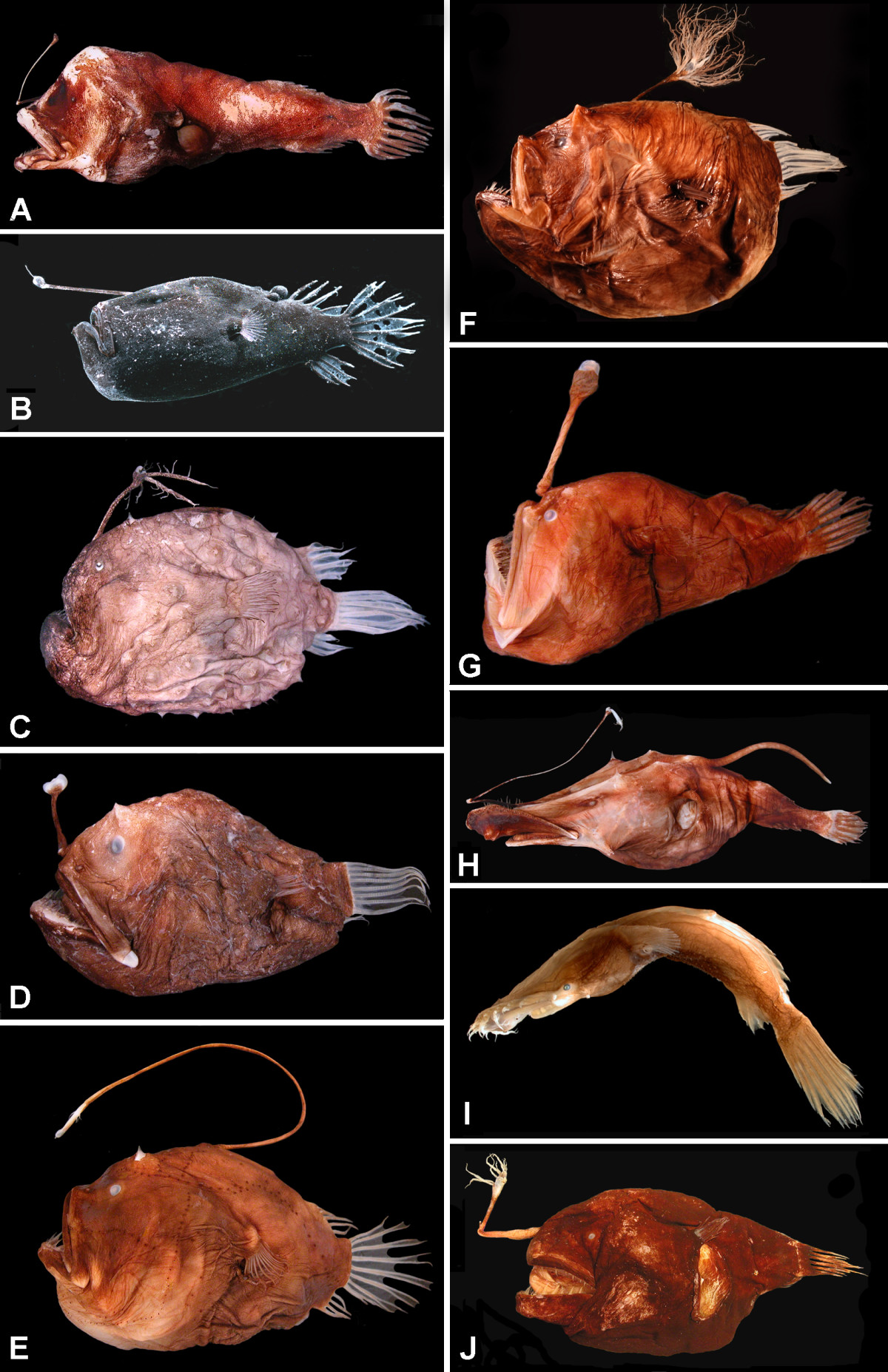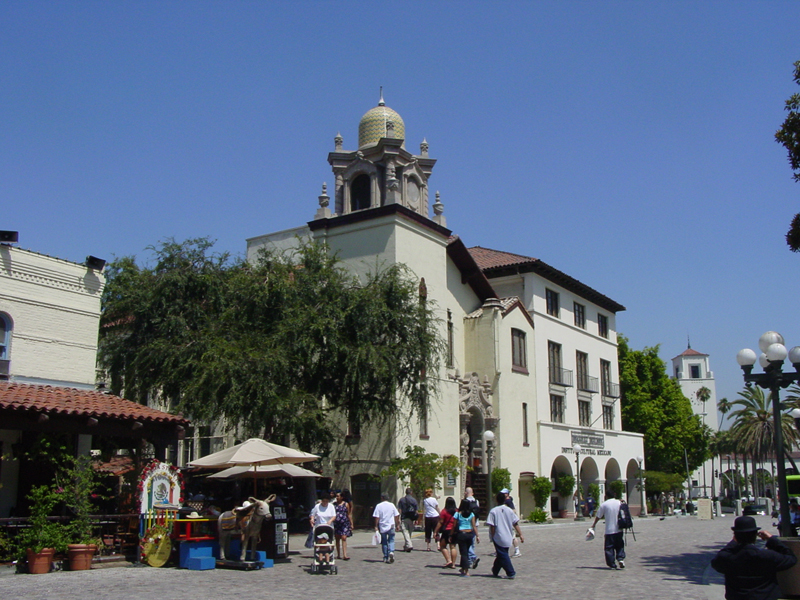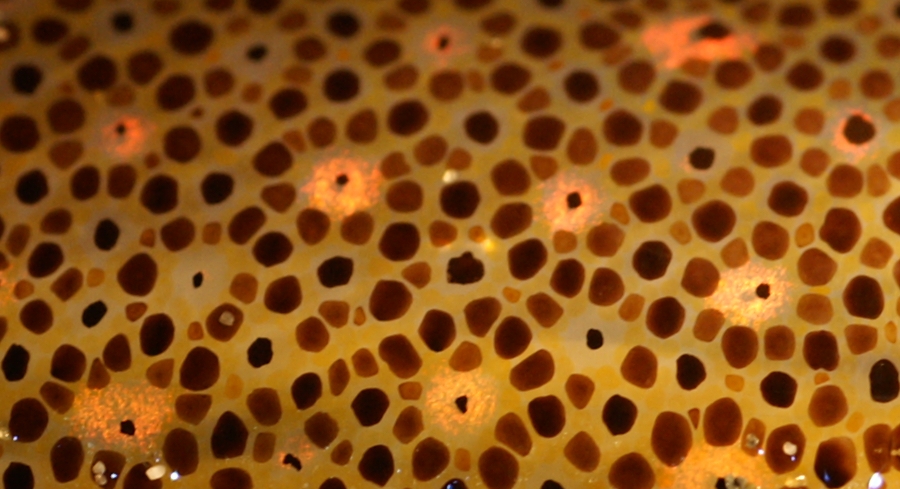|
Linophryne Indica
''Linophryne indica'', or headlight angler, is a leftvent anglerfish in the family Linophrynidae, found in the bathyal zone of the Pacific Ocean at depths below 1,000 m (3,300 ft). The female is significantly larger than the mature male. A fossil specimen of this species has been found in the Los Angeles Basin dating back to the Late Miocene, some eight million years ago. Description The mature female ''Linophryne indica'' has a laterally compressed, oval body. The head is broad and the large, oblique mouth extends behind the eye. The teeth are large and sharp, there being four longitudinal rows in the upper jaw and three in the lower jaw, as well as a single pair of vomerine teeth in the roof of the mouth. The sphenotic spines (above the eyes) are large and there is a prominent angulare spine. The illicium on the snout is short and broadens into the rather larger esca at its tip. This has a number of short filaments and a long trailing appendage. There is a barbel o ... [...More Info...] [...Related Items...] OR: [Wikipedia] [Google] [Baidu] |
Tortonian
The Tortonian is in the geologic time scale an age or stage of the late Miocene that spans the time between 11.608 ± 0.005 Ma and 7.246 ± 0.005 Ma (million years ago). It follows the Serravallian and is followed by the Messinian. The Tortonian roughly overlaps with the regional Pannonian Stage of the Paratethys timescale of Central Europe. It also overlaps the upper Astaracian, Vallesian and lower Turolian European land mammal ages, the upper Clarendonian and lower Hemphillian North American land mammal ages and the upper Chasicoan and lower Huayquerian South American land mammal ages. Definition The Tortonian was introduced by Swiss stratigrapher Karl Mayer-Eymar in 1858. It was named after the Italian city of Tortona in the region Piedmont. The base of the Tortonian Stage is at the last common appearance of calcareous nanoplankton ''Discoaster kugleri'' and planktonic foram '' Globigerinoides subquadratus''. It is also associated with the short normal pol ... [...More Info...] [...Related Items...] OR: [Wikipedia] [Google] [Baidu] |
Anglerfish
The anglerfish are fish of the teleost order Lophiiformes (). They are bony fish named for their characteristic mode of predation, in which a modified luminescent fin ray (the esca or illicium) acts as a lure for other fish. The luminescence comes from symbiotic bacteria, which are thought to be acquired from seawater, that dwell in and around the sea. Some anglerfish are notable for extreme sexual dimorphism and sexual symbiosis of the small male with the much larger female, seen in the suborder Ceratioidei, the deep sea anglerfish. In these species, males may be several orders of magnitude smaller than females. Anglerfish occur worldwide. Some are pelagic (dwelling away from the sea floor), while others are benthic (dwelling close to the sea floor). Some live in the deep sea (such as the Ceratiidae), while others on the continental shelf, such as the frogfishes and the Lophiidae (monkfish or goosefish). Pelagic forms are most often laterally compressed, whereas th ... [...More Info...] [...Related Items...] OR: [Wikipedia] [Google] [Baidu] |
Extant Taxon
Neontology is a part of biology that, in contrast to paleontology, deals with living (or, more generally, ''recent'') organisms. It is the study of extant taxa (singular: extant taxon): taxa (such as species, genera and families) with members still alive, as opposed to (all) being extinct. For example: * The moose (''Alces alces'') is an extant species, and the dodo (''Raphus cucullatus'') is an extinct species. * In the group of molluscs known as the cephalopods, there were approximately 600 extant species and 7,500 extinct species. A taxon can be classified as extinct if it is broadly agreed or certified that no members of the group are still alive. Conversely, an extinct taxon can be reclassified as extant if there are new discoveries of living species (" Lazarus species"), or if previously-known extant species are reclassified as members of the taxon. Most biologists, zoologists, and botanists are in practice neontologists, and the term neontologist is used ... [...More Info...] [...Related Items...] OR: [Wikipedia] [Google] [Baidu] |
Los Angeles
Los Angeles ( ; es, Los Ángeles, link=no , ), often referred to by its initials L.A., is the largest city in the state of California and the second most populous city in the United States after New York City, as well as one of the world's most populous megacities. Los Angeles is the commercial, financial, and cultural center of Southern California. With a population of roughly 3.9 million residents within the city limits , Los Angeles is known for its Mediterranean climate, ethnic and cultural diversity, being the home of the Hollywood film industry, and its sprawling metropolitan area. The city of Los Angeles lies in a basin in Southern California adjacent to the Pacific Ocean in the west and extending through the Santa Monica Mountains and north into the San Fernando Valley, with the city bordering the San Gabriel Valley to it's east. It covers about , and is the county seat of Los Angeles County, which is the most populous county in the United States with an ... [...More Info...] [...Related Items...] OR: [Wikipedia] [Google] [Baidu] |
Borophryne Apogon
''Borophryne apogon'', the netdevil, or greedy seadevil, is a species of leftvent anglerfish known today from the waters of the eastern Pacific Ocean off the Central American coast. It is found at depths down to around . This species grows to a length of TL. A fossil specimen of this species has been found in the Los Angeles Basin dating back to the Late Miocene, some eight million years ago. Description A metamorphosed female ''Borophryne apogon'' is globose, and grows to a maximum length of about . The depth of the head is between 50% and 65% of the fish's standard length and the length of the head is between 50% and 60% of the standard length, with the lower jaw being four fifths of the length of the head. Three rows of long, sharp teeth line the jaws and there are up to four teeth on the roof of the mouth. The illicium on the snout is short and the esca on its tip is large with a branching terminal appendage and filaments on the side. There is a rounded protuberance on t ... [...More Info...] [...Related Items...] OR: [Wikipedia] [Google] [Baidu] |
Fossil
A fossil (from Classical Latin , ) is any preserved remains, impression, or trace of any once-living thing from a past geological age. Examples include bones, shells, exoskeletons, stone imprints of animals or microbes, objects preserved in amber, hair, petrified wood and DNA remnants. The totality of fossils is known as the ''fossil record''. Paleontology is the study of fossils: their age, method of formation, and evolutionary significance. Specimens are usually considered to be fossils if they are over 10,000 years old. The oldest fossils are around 3.48 billion years old to 4.1 billion years old. Early edition, published online before print. The observation in the 19th century that certain fossils were associated with certain rock strata led to the recognition of a geological timescale and the relative ages of different fossils. The development of radiometric dating techniques in the early 20th century allowed scientists to quantitatively measure the abs ... [...More Info...] [...Related Items...] OR: [Wikipedia] [Google] [Baidu] |
Bathypelagic Zone
The bathypelagic zone or bathyal zone (from Greek βαθύς (bathýs), deep) is the part of the open ocean that extends from a depth of below the ocean surface. It lies between the mesopelagic above, and the abyssopelagic below. The bathypelagic is known as the midnight zone because of the lack of sunlight; this feature does not allow for photosynthesis-driven primary production, preventing growth of phytoplankton or aquatic plants. Although larger by volume than the photic zone, our knowledge of the bathypelagic zone remains limited by our ability to explore the deep ocean. Physical characteristics The bathypelagic zone is characterized by a nearly constant temperature of approximately and a salinity range of 33-35 g/kg. This region has little to no light, because sunlight does not reach this deep in the ocean and bioluminescence is limited. The hydrostatic pressure in this zone ranges 100-400 atmospheres (atm), due to the increase of 1 atm for every 10 m depth. It is beli ... [...More Info...] [...Related Items...] OR: [Wikipedia] [Google] [Baidu] |
Mesopelagic Zone
The mesopelagic zone (Greek μέσον, middle), also known as the middle pelagic or twilight zone, is the part of the pelagic zone that lies between the photic epipelagic and the aphotic bathypelagic zones. It is defined by light, and begins at the depth where only 1% of incident light reaches and ends where there is no light; the depths of this zone are between approximately 200 to 1,000 meters (~656 to 3,280 feet) below the ocean surface. The mesopelagic zone occupies about 60% of the planet's surface and about 20% of the ocean's volume, amounting to a large part of the total biosphere. It hosts a diverse biological community that includes bristlemouths, blobfish, bioluminescent jellyfish, giant squid, and a myriad of other unique organisms adapted to live in a low-light environment. It has long captivated the imagination of scientists, artists and writers; deep sea creatures are prominent in popular culture. Physical conditions The mesopelagic zone includes the regi ... [...More Info...] [...Related Items...] OR: [Wikipedia] [Google] [Baidu] |
Chromatophore
Chromatophores are cells that produce color, of which many types are pigment-containing cells, or groups of cells, found in a wide range of animals including amphibians, fish, reptiles, crustaceans and cephalopods. Mammals and birds, in contrast, have a class of cells called melanocytes for coloration. Chromatophores are largely responsible for generating skin and eye colour in ectothermic animals and are generated in the neural crest during embryonic development. Mature chromatophores are grouped into subclasses based on their colour (more properly "hue") under white light: xanthophores (yellow), erythrophores (red), iridophores (reflective / iridescent), leucophores (white), melanophores (black/brown), and cyanophores (blue). While most chromatophores contain pigments that absorb specific wavelengths of light, the color of leucophores and iridophores is produced by their respective scattering and optical interference properties. Some species can rapidly change colour through ... [...More Info...] [...Related Items...] OR: [Wikipedia] [Google] [Baidu] |
Vomer
The vomer (; lat, vomer, lit=ploughshare) is one of the unpaired facial bones of the skull. It is located in the midsagittal line, and articulates with the sphenoid, the ethmoid, the left and right palatine bones, and the left and right maxillary bones. The vomer forms the inferior part of the nasal septum in humans, with the superior part formed by the perpendicular plate of the ethmoid bone. The name is derived from the Latin word for a ploughshare and the shape of the bone. In humans The vomer is situated in the median plane, but its anterior portion is frequently bent to one side. It is thin, somewhat quadrilateral in shape, and forms the hinder and lower part of the nasal septum; it has two surfaces and four borders. The surfaces are marked by small furrows for blood vessels, and on each is the nasopalatine groove, which runs obliquely downward and forward, and lodges the nasopalatine nerve and vessels. Borders The ''superior border'', the thickest, presents a d ... [...More Info...] [...Related Items...] OR: [Wikipedia] [Google] [Baidu] |
August Brauer
August Bernhard Brauer (3 April 186310 September 1917) was a German zoologist. Brauer was born in Oldenburg. He studied natural sciences at the Universities of Bonn, Berlin and Freiburg, obtaining his doctorate in 1895 with a thesis on the ciliate- ''Bursaria truncatella'' titled ''Bursaria truncatella unter Berücksichtigung anderer Heterotrichen und der Vorticellinen''. In 1892 he received his habilitation at the University of Marburg, where he subsequently worked as a lecturer. In 1894–95 he conducted scientific studies in the Seychelles. With other scientists he participated in the "1898–99 German Deep-Sea Expedition" aboard the steamer ''Valdivia'' under the leadership of Carl Chun (1852–1914). In 1906 he was named director of the Berlin Zoological Museum (nowadays the Berlin's Natural History Museum), and later in his career he attained the title of "full professor". Brauer distinguished himself in the field of deep-sea ichthyology, based largely on his experiences ... [...More Info...] [...Related Items...] OR: [Wikipedia] [Google] [Baidu] |





